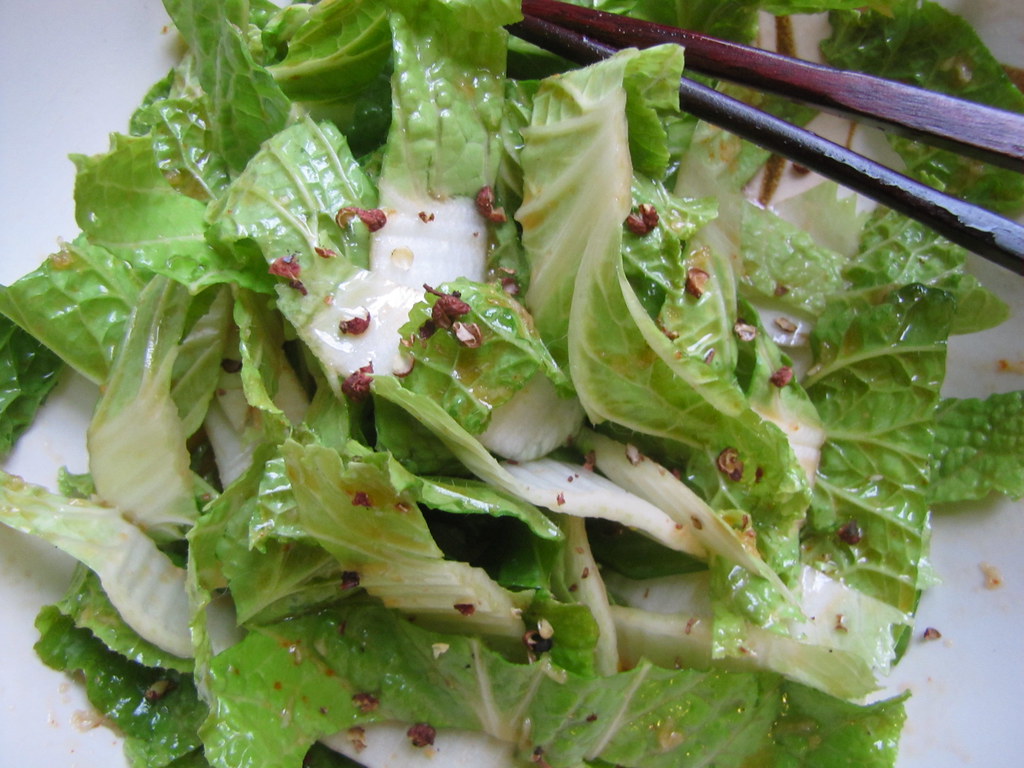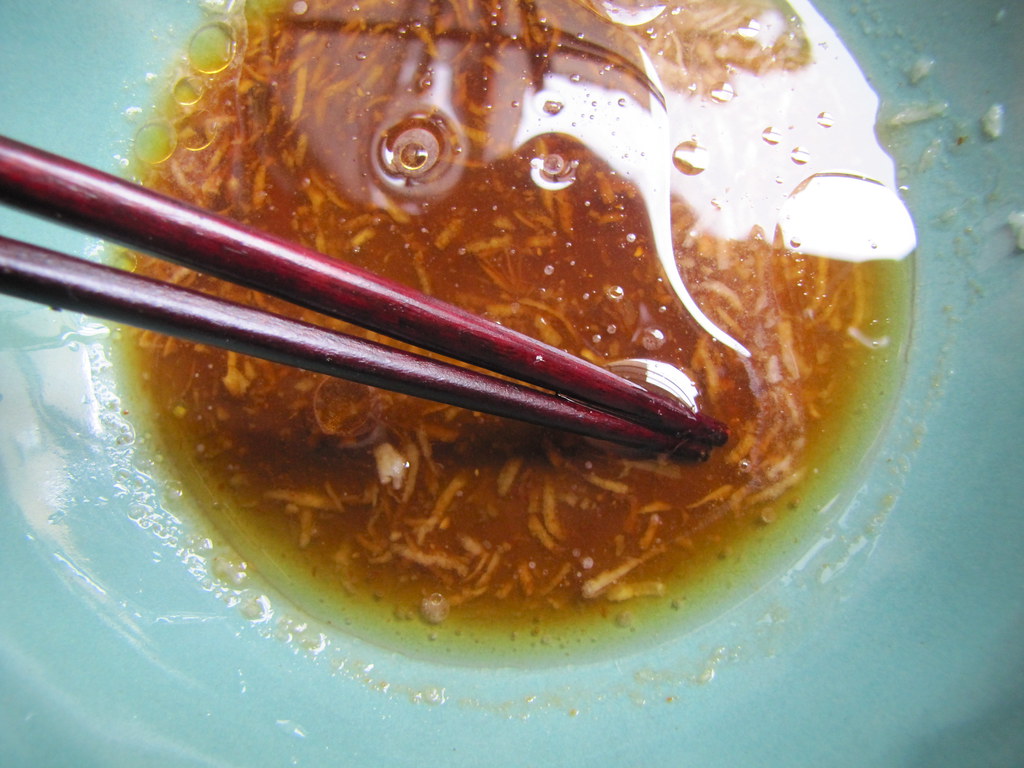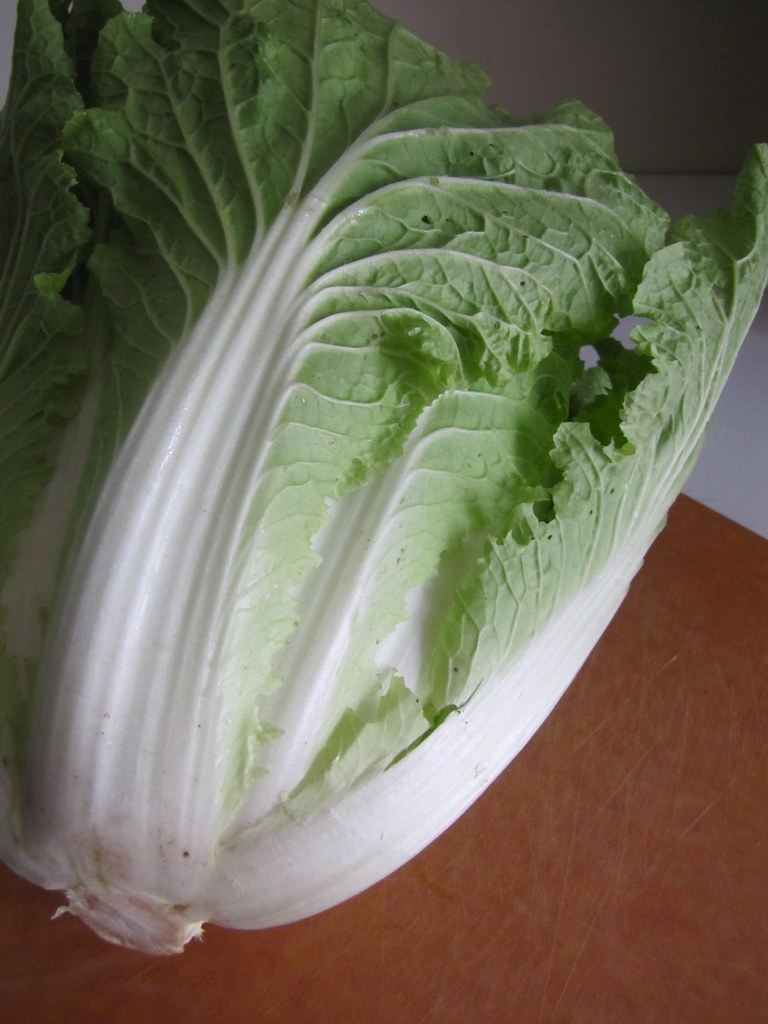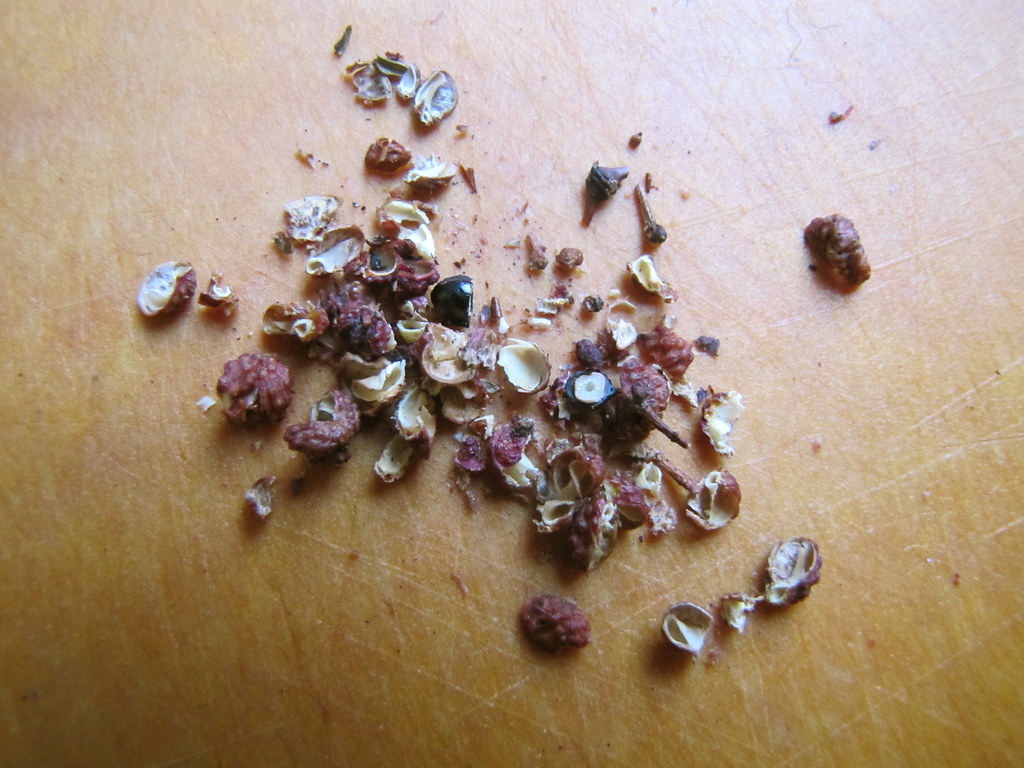
Last week, I got a beautiful, billowy head of napa cabbage in my CSA share. There were only about three other people picking up their shares at the same time as me, but I was able to overhear the same concerns: “What do I do with napa cabbage?” Naturally, I was determined to find a crowd-pleasing application.
This might not be the most go-to solution as far as fresh salads of napa cabbage go. But I’ve been addicted to all things Szechuan lately, and their distinctive style of dressing cold appetizers has just been blowing my mind. Sure, you can sautee with garlic leafy chunks of napa cabbage just like any other green. You can also throw them into soups or in this warm weather, dress with any other type of salad dressing. But the pungent, piquant and lingeringly-spicy oil in this cold dish is definitely memorable — plus, it can be applied to a lot of other vegetables, like chopped cucumbers, too.
Napa cabbage has a very cooling effect, I think, which plays up well against spicy flavors. With its thick, white stalk, it stays crunchy and firm well after soaking in oils, unlike many lettuces. If you’re a fan of kimchee but not quite its sodden texture, try giving this quickly-marinated salad a chance instead.
 minced garlic, chili oil, sesame oil, soy sauce and sugar is quickly mixed
minced garlic, chili oil, sesame oil, soy sauce and sugar is quickly mixed
This dressing is fashioned after a combination of garlicky, quick-pickled cucumbers that I grew up with, and spicy chile-oil soaked Szechuan cold dishes. To the latter theme, the final product is sprinkled with freshly crushed Szechuan peppercorns, which have a signature numbing effect on the palate. Floral and peppery in flavor, these aren’t very spicy on their own. But when combined with hot chiles, you get a classic ma-la effect — la, for the heat of the chiles, and ma, for the weirdly numbing sensation of the peppercorns. If you haven’t tried Szechuan peppercorns alone before, you’re in for a really strange surprise; so tingly and numb it makes it feel, your tongue might not know what has happened to it.
All that said, you don’t have to have this exact same flavor combination to make a tasty napa cabbage salad in the same vein. Try mixing up some sesame oil with sriracha, freshly chopped garlic, soy sauce, sesame oil and sugar to soak your freshly cut leaves in alone, and adjust the level of heat as desired. The combination is potent enough, and the napa cabbage soaks in flavor like a sponge, so to be conservative (without sacrificing much crunchiness), let your salad chill covered about thirty minutes until serving. It’s a good side dish to bring to potlucks and picnics because of this.
Napa Cabbage with Chili-Garlic Sauce and Szechuan Peppercorns
(makes 4-6 servings)
1/2 large head napa cabbage, coarsely chopped
1 clove garlic, minced
3 tablespoons sesame oil
2 tablespoon red chili oil
1 teaspoon Sriracha (or chili-garlic sauce)
2 teaspoons sugar
2 teaspoons soy sauce
1 tablespoon rice vinegar
1 tablespoon whole Szechuan peppercorns, gently crushed
Whisk together the garlic, sesame oil, chili oil Sriracha, sugar, soy sauce and rice vinegar. Toss with the napa cabbage. Chill covered for 30 minutes, preferably, before serving. Stir once or twice as it chills, if possible. Sprinkle with the crushed peppercorns, and serve.
Cost Calculator
(for 4-6 servings)
1/2 head napa cabbage: $2.00
1 clove garlic: $0.20
3 tablespoons sesame oil: $0.40
2 tablespoons chili oil: $0.30
1 teaspoon Sriracha: $0.10
2 teaspoons sugar: $0.10
2 teaspoons soy sauce: $0.10
1 tablespoon rice vinegar: $0.25
1 tablespoon Szechuan peppercorns: $0.25
Total: $3.70
Health Factor![]()
![]()
![]()
Three brownie points: Napa cabbage eaten fresh is a turbo-boost of vitamins, like most leafy cabbages or brassicas. Contained within its pale green leaves are plentiful antioxidants like Vitamin C, B-vitamins, fiber and Vitamin A, and are low on calories and natural sugars, even more so than green or red cabbage. Its more watery character is apparent in the lightness that its leaves feel when chopped coarsely, rather than finely shredding, so you’re getting a little bit less of all of the above while adding an appealing crunch in a raw salad.
Green Factor![]()
![]()
![]()
![]()
![]()
![]()
![]()
Seven maple leaves: Many small, organic or “specialty” (i.e. non-industrial crop-growing) farms have adopted Asian vegetables in the last few decades, such as bok choy and napa cabbage, into their regular growing schedules. The scope is broadening even more, but thanks to them these once-exotic vegetables are now much more easily found at the local farmers’ market. (Or a CSA share, where I got my napa cabbage.) While the garlic was also locally-sourced, I can’t say the same for the rest of the condiments, although they are kitchen staples I can’t live without.



4 Responses
Deborah Dowd
This sounds like a great side for a more mellow protein like a grilled chicken or fish- a nice change from cole slaw!
brian
i was just in china for the first time and fell in love with Szechuan food…where do you get your peppers from?
Cathy Erway
@brian — Cool! (or hot?). I got mine from Hong Kong Supermarket on Elizabeth & Essex St. in Manhattan, but any Asian grocery or dry-goods store should have Szechuan peppercorns, and pretty cheaply, too.
Meister @ The Nervous Cook
Napa cabbage is so delicious — I can’t wait till my first CSA delivery of the stuff! I like to use it as a replacement for tortillas when making tacos or fajitas (and, of course, who can resist a little kimchi action?).